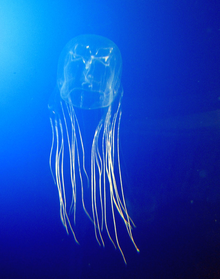Chironex fleckeri
| Chironex fleckeri | |
|---|---|
 |
|
| Chironex sp. | |
| Scientific classification | |
| Kingdom: | Animalia |
| Phylum: | Cnidaria |
| Class: | Cubozoa |
| Order: | Chirodropida |
| Family: | Chirodropidae |
| Genus: | Chironex |
| Species: | C. fleckeri |
| Binomial name | |
|
Chironex fleckeri Southcott, 1956 |
|
 |
|
| Range of Chironex fleckeri as traditionally defined, but see text. | |
Chironex fleckeri, commonly known as sea wasp, is a species of deadly venomous box jellyfish found in coastal waters from northern Australia and New Guinea north to the Philippines and Vietnam. It has been described as "the most lethal jellyfish in the world", with at least 63 known deaths in Australia from 1884 to 1996.
Notorious for its sting, C. fleckeri has tentacles up to 3 m (9.8 ft) long covered with millions of cnidocytes which, on contact, release microscopic darts delivering an extremely powerful venom. Being stung commonly results in excruciating pain, and if the sting area is significant, an untreated victim may die in two to five minutes. The amount of venom in one animal is said to be enough to kill 60 adult humans (although most stings are mild).
Chironex fleckeri was named after North Queensland toxicologist and radiologist Doctor Hugo Flecker. "On January 20, 1955, when a 5-year-old boy died after being stung in shallow water at Cardwell, north Queensland, Flecker found three types of jellyfish. One of which was an unidentified: a box-shaped jellyfish with groups of tentacles arising from each corner. Flecker sent it to Dr Ronald Southcott in Adelaide, and on December 29, 1955, Southcott published his article introducing it as a new Genus and species of lethal box jellyfish. He named it Chironex fleckeri, the name being derived from the Greek `cheiro' meaning `hand', and the Latin `nex' meaning `murderer', and `fleckeri' in honour of its discoverer."
Chironex fleckeri is the largest of the cubozoans (collectively called box jellyfish), many of which may carry similarly toxic venom. Its bell grows to about the size of a basketball. From each of the four corners of the bell trails a cluster of 15 tentacles. The pale blue bell has faint markings; viewed from certain angles, it bears a somewhat eerie resemblance to a human head or skull. Since it is virtually transparent, the creature is nearly impossible to see in its habitat, posing particular danger to swimmers.
When the jellyfish are swimming, the tentacles contract so they are about 15 cm long and about 5 mm in diameter; when they are hunting, the tentacles are thinner and extend to about 3 m long. The tentacles are covered with a high concentration of stinging cells called cnidocytes, which are activated by pressure and a chemical trigger; they react to proteinous chemicals. Box jellyfish are day hunters; at night they are seen resting on the ocean floor, apparently 'sleeping'. However, this 'sleeping' theory is still debated.
...
Wikipedia
